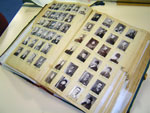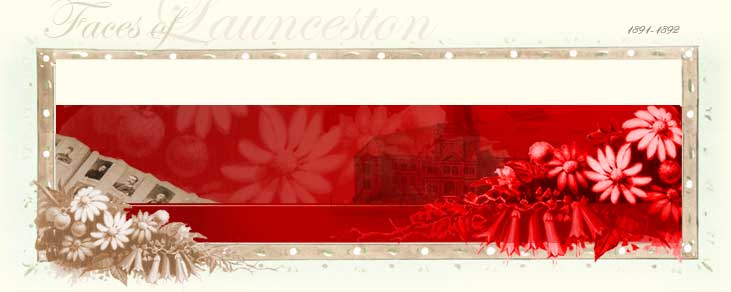The Tasmanian Exhibition of 1891-92
and the Launceston Family Album Project
 The Tasmanian Exhibition of 1891-92 was the biggest event ever held in Launceston. It was years in the planning, much of it under the leadership of Samuel Sutton, who became mayor in 1890, and with the enthusiastic guidance of a committee formed in August 1888.
The Tasmanian Exhibition of 1891-92 was the biggest event ever held in Launceston. It was years in the planning, much of it under the leadership of Samuel Sutton, who became mayor in 1890, and with the enthusiastic guidance of a committee formed in August 1888.
The Exhibition was widely promoted in Britain and the colonies as a trade fair, cultural exhibition and expression of community achievement. It opened on November 25, 1891 and ran for over four months. ‘This great undertaking’, as it was described in the Official Record of the Tasmanian Exhibition 1891-92 published during the general euphoria following its conclusion, had been greeted with ‘universal satisfaction’.
The Exhibition, staged at a total cost of £14,480, was housed in the Albert Hall, purpose built for the event, as were the temporary annexes holding the displays. Exhibitors came from all the Australian colonies, Great Britain, France, Germany, Austria, Italy, Switzerland, the United States and New Zealand; there were 1372 in all.
 The portraits featured in this website are an almost chance preservation of studio photographs taken to provide season tickets to the Exhibition. A portrait was mounted on each season ticket to create what was effectively a passport for admission that identified the ticket holder. Season tickets to the Exhibition were issued at a cost of two guineas for gentlemen, one guinea for ladies and 10/6 for children under fourteen. They also gave admission to the opening ceremonies, concerts and oratorios.
The portraits featured in this website are an almost chance preservation of studio photographs taken to provide season tickets to the Exhibition. A portrait was mounted on each season ticket to create what was effectively a passport for admission that identified the ticket holder. Season tickets to the Exhibition were issued at a cost of two guineas for gentlemen, one guinea for ladies and 10/6 for children under fourteen. They also gave admission to the opening ceremonies, concerts and oratorios.
A master set of passport photographs was kept by the official photographer for the Exhibition, Richard Nicholas, in a large half-bound scrapbook. This scrapbook, effectively an album divided like an address book into alphabetic sections, survived its immediate use and was donated to the Launceston Library in 1950 by RWJ Hart from the estate of AW Joscelyne, one of the original Commissioners of the Exhibition. It is fragile, and is publicly accessible only through digital images of it. Into it are pasted 1186 photographic portraits, 3.8 x 5.2 cm, grouped under the first letter of the surname of the subject.
 These head and shoulder portraits of smartly-dressed men, women and children provide us now with an unusually representative photographic record of the city’s population at that time. Their excellence technically and the artistic handling of their subjects justified the Commissioners’ confidence in Nicholas’s professional skills. Collectively they were a detailed visual record of individuals and of the great variety in styles of clothing, hats and hairdressing – including facial hair of mature men – that prevailed in Tasmania 120 years ago. Boys commonly wore sailor suits. Nurses were shown in their uniforms. Very young children were accompanied by a sibling or an unnamed nanny.
These head and shoulder portraits of smartly-dressed men, women and children provide us now with an unusually representative photographic record of the city’s population at that time. Their excellence technically and the artistic handling of their subjects justified the Commissioners’ confidence in Nicholas’s professional skills. Collectively they were a detailed visual record of individuals and of the great variety in styles of clothing, hats and hairdressing – including facial hair of mature men – that prevailed in Tasmania 120 years ago. Boys commonly wore sailor suits. Nurses were shown in their uniforms. Very young children were accompanied by a sibling or an unnamed nanny.
Portraits sometimes reveal a glimpse of a chair, showing that the subject was sitting; in others a hand resting on a wall shows they were standing. From surviving RJ Nicholas Studio portraits we know that some of these passport photographs were cut out from larger prints that reveal full figures in specific studio settings.
As a visual index to the studio’s work the portraits no doubt were very useful, but as a means for a modern researcher to identify the subject, they create quite a few problems. The names are written by at least three different hands, some are hard to decipher due to stylistic flourishes, fading or over-writing, some have been misspelled, perhaps as a result of mishearing or using an alternative spelling of a name, and most give minimal information.
Most commonly a surname and an initial identify the subject. Sometimes this initial is of the name they were familiarly known by rather than the birth certificate first name; for married women the initial is most often that of their husband’s name rather than their own. In many instances there is no initial, merely Mr, Mrs or Miss (perhaps indicating the eldest daughter in a family) and at times there is only a surname. “Smith” is a particularly unhelpful label. In two instances there is no name at all under the portrait.
The Friends of the Library Launceston, supported by a 2005 Tasmanian Community Fund grant, had a set of digital images made of the portraits. Then through an interactive website (www.launcestonfamilyalbum.org.au) developed and hosted by Hobart IT firm Future Medium, supported by a supplement to The Examiner published at the same time, it invited members of the public to join in a detective investigation. The challenge was to find out who these people were, and with that, what their part in creating the heritage of Launceston was, where they lived, what their stories were, and who their families and descendants were.
Supplementing this public appeal, Launceston Library (Launceston LINC) staff and volunteers based in the Library used a number of published and unpublished resources to assist in identifying images and filling out the stories as accurately as possible at this distance in time. It ended up taking some six years of patient but rewarding research. A list of the materials gathered during the project, now archived at Launceston LINC, can be found online at http://search.archives.tas.gov.au/default.aspx?detail=1&type=S&id=LMSS660.
The identification of individuals has usually been based on circumstantial evidence because confirmation by means of another photograph was not available. When there is doubt in identification, the words “This is possibly” preface the biographical details. It should be borne in mind that entries not having this proviso may still be mistakenly attributed to their corresponding image in the album.
It is hoped that evidence will continue to be found that confirms or corrects the information given in this website. Users should refer to original sources if they wish to confirm the validity of the information supplied here.
Readers of the web entries should bear in mind that:
- Places referred to in the text are most often in Tasmania or on mainland Australia. The North-East and similar geographical areas are recognised terms applying to parts of the island of Tasmania.
- It is assumed that readers will be aware of the whereabouts of the principal cities, counties etc of other countries such as England and New Zealand.
- Carr Villa Cemetery (now Carr Villa Memorial Park) is in Launceston. Cornelian Bay Cemetery is in Hobart.
- Several Launceston cemeteries no longer exist, including the general cemetery in Charles Street, the Anglican cemetery in Cypress Street, the Catholic cemetery in Connaught Crescent, the Scotch Cemetery in High Street and the Quaker Cemetery in Pedder Street.
- Sometimes it has been possible to determine only that the photo is one of several members of the same family and often only one of these is in the title of the entry.
- The Examiner has been used to refer both to the Launceston Examiner, published from 1842-1899 and the Examiner, published from 1900 onwards.
- Information relating to a particular name is likely to be accurate, however identification of that person as the one in the photograph may not be correct.
- Trove digitised newspapers came online during the time of this project. Additional material on individuals in the album may be available on this website. Access to wills on the Tasmanian Archives site was also not available at the beginning of this project.
There has been a number of outcomes of the Launceston Family Album project. From September 2005 to August 2007 101 weekly illustrated articles appeared in The Examiner focussing on families appearing in the album, and most of these were collected in an archival volume Launceston Family Album published in 2007. In 2011 a two-CD set was produced by Gould Genealogy and History. Disc1 includes all the data collected in the Launceston Family Album, in a form that is keyword searchable; Disc 2 is devoted to background information and images associated with the Exhibition.
In 2013 a 350 page hardbound book, The Tasmanian Exhibition 1891-92, published by the Friends of the Library and compiled by Prue McCausland and Marion Sargent was produced by Bokprint. It tells in greater detail the story of the Exhibition, its organisers and exhibitors, and the people who attended, and is profusely illustrated with contemporary photographs. It also contains all the information of this website. Copies are held in the National Library as well as the State Libraries of Victoria, NSW and Tasmania.
This website is maintained by JKB Web Solutions and hosted by Island Hosting, Launceston, and has been updated in August 2015. Friends of the Library, Launceston hopes to keep the website, and the project, alive for many years to come.
